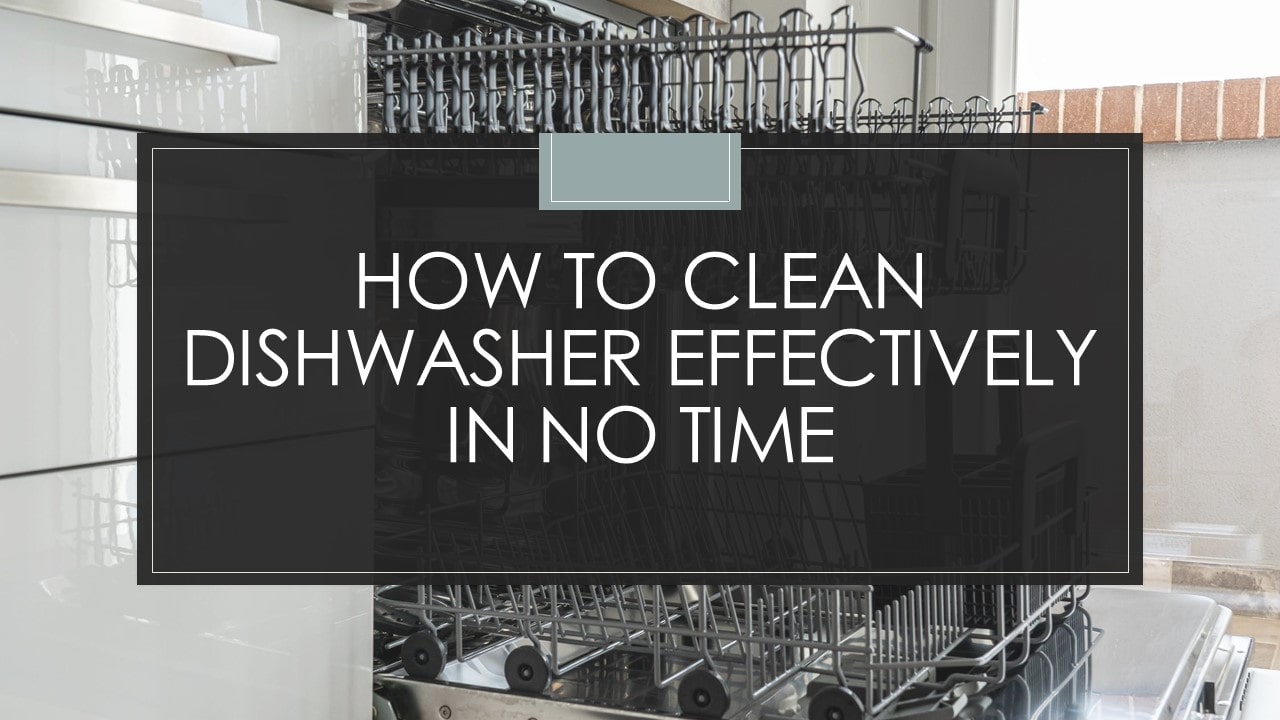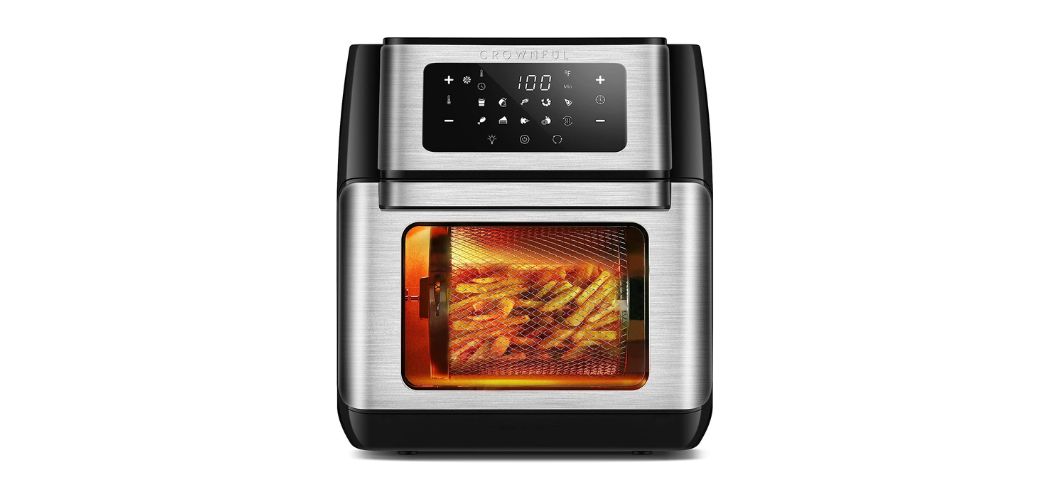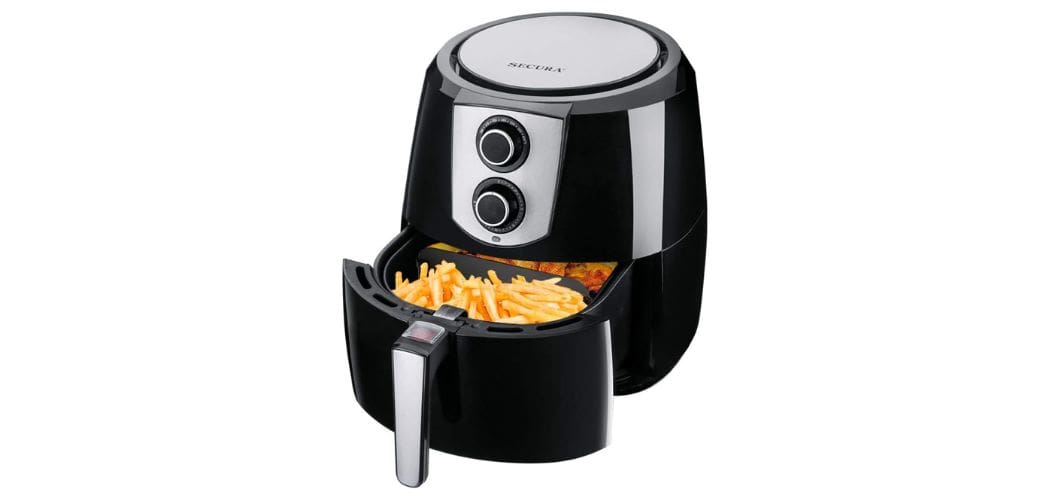Do you think your dishwasher gets spick and span each time you run it through a cycle? No, it is not like that. It is not enough to keep your dishwasher clean; a deep cleaning is required once in a while.
It is because regular cleaning with water leaves food residue inside the dishwasher. You will witness incredible results on deep cleaning your appliance. Food scraps, grease, and soap scum can hamper the dishwasher’s performance.
It can damage the appliance’s pump and filter. It leaves an unpleasant odor and leaves spots and film on your dinnerware and glassware.
So, how do you clean your dishwasher at home quickly? We have brought the article to help you learn how to clean the dishwasher effectively in no time.
Table of Contents
How Often Should A Dishwasher Be Cleaned?
A fresh-looking and smelling dishwasher will ensure cleaner cookware.
It is time to deep clean your dishwasher as soon as your dishes come out with a foul smell and gunk sticks to them.
So, cleaning a dishwasher mainly depends on your frequency of usage and how you maintain it regularly.
Usually, deep cleaning a dishwasher from the inside once every two-three months will keep it running optimally for a long time.
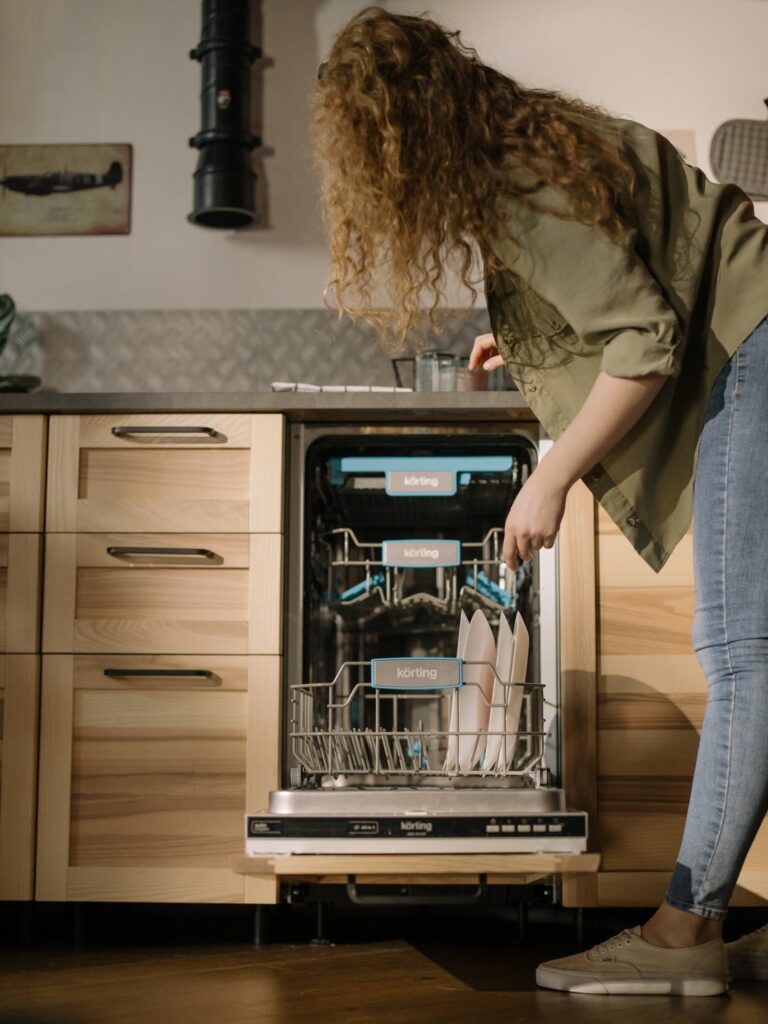
Tools and Materials Required
- Baking soda
- Warm water
- Toothbrush
- Microfiber cloth
- White vinegar
- Rubber gloves
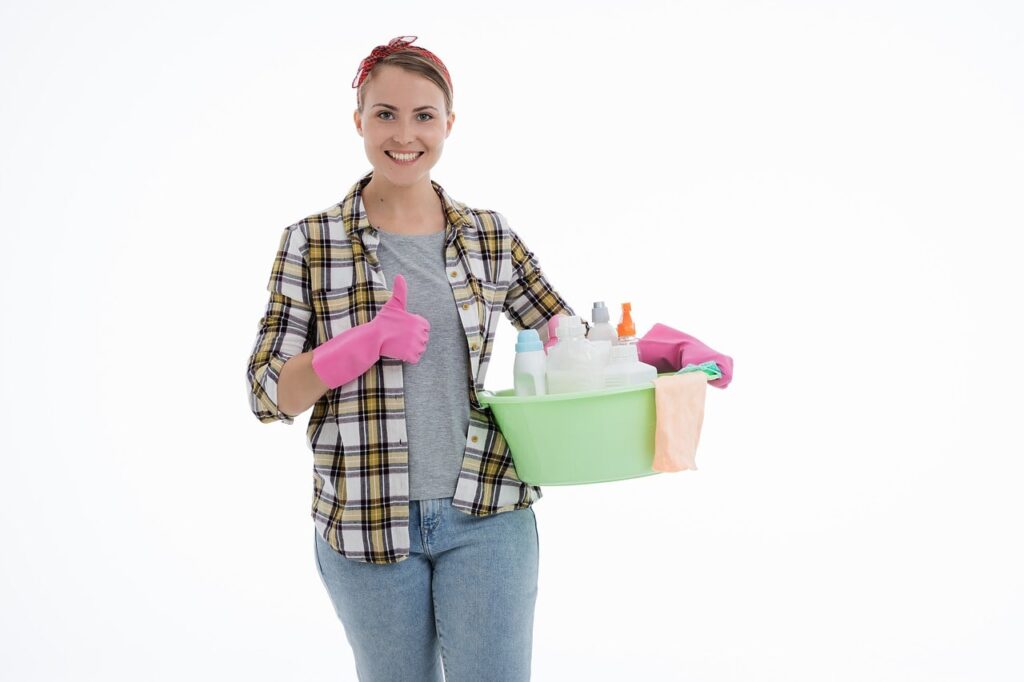
Steps to Clean A Dishwasher
Clean your dishwasher effectively by performing the below steps.
1. Clean the dishwasher drain
Examine the area around the drain after wearing rubber gloves. Remove any food chunks or grease you find. The debris impedes the drainage and damages your appliance.
2. Remove the dishwasher parts
You will have to remove the utensil holders, racks, and filter (if your dishwasher has a removable filter).
If you want to learn how to clean your dishwasher filter effectively then make sure to read our 7 steps.
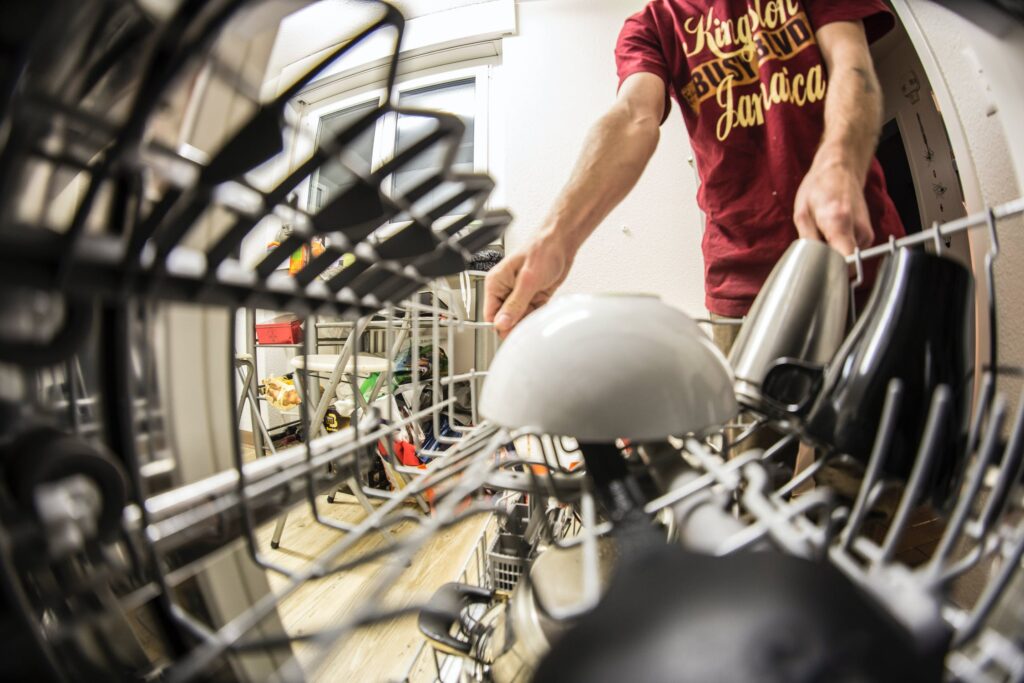
Place the parts in a mixture of 1 cup of white distilled vinegar and warm water. Leave them and allow them to soak in the mixture for 30 minutes.
3. Clear the debris
Check for any hiding debris in the dishwasher. Wipe the sidewalls and spray arms, especially in the corners at the top and bottom.
Look for any clogging inside the tiny holes and slots where water sprays out. Use a toothpick or toothbrush to clean clogged food particles or debris stuck on tiny surfaces.
4. Run a hot water cycle
Fill a bowl that is dishwasher-safe with 1 cup of white vinegar. Place it on the empty dishwasher’s bottom. Run a hot water cycle on the dishwasher. The vinegar will effectively break down grease, food particles, soap scum, and leftover residue.
White vinegar also clears away old detergent accumulation and dissolves mineral deposits that build up after endless washing of dirty dishes. White vinegar neutralizes food odors preventing your dishwasher from smelling foul.
5. Run short wash cycle
Remove the bowl containing vinegar after the cycle ends from the dishwasher. Now, sprinkle 1 cup of baking soda and the corners of the dishwasher bottom. Run it on a short wash cycle. What will baking soda do?
The baking soda has an abrasive nature that will act as a scrub for the dishwasher. It will remove stains that result in a clean and sparkling dishwasher and smells fresh.
But please do not try to skip one step by placing the vinegar and baking soda together in the dishwasher. It will end up in a mess.
6. Wipe the rubber seal
The rubber gasket present around the door gets dirty with regular use. Use hot, soapy water and a towel to wipe away grease on the gasket.
Other Ways of Cleaning Dishwasher
Lemonade mix
If you do not want to use vinegar, you can also use unsweetened lemonade mix for cleaning the dishwasher. Run a wash cycle on the dishwasher after pouring the lemonade mix powder into a detergent dispenser.
The lemonade mix has citric acid that works similar to vinegar cutting through the stuck food particles. Look for unsweetened lemonade that has citric acid while buying it.
What if you do not have a lemonade mix handy? Try running a wash cycle with a cup of lemon juice and placing it in the dishwasher’s top rack.
DIY cleaner
You can make your own cleaner at home. Prepare a mixture of dish soap, white vinegar, and water. It will give you a great homemade cleaner safe for all dishwasher surfaces.
Take soapy water and soak a microfiber cloth in it. Swipe in the surface’s grain direction. Rinse your cloth and pass it over the surface again for a glossy finish. Do not forget to wipe down the handles and control panel with a damp cloth.
Rubbing Alcohol
Use rubbing alcohol for cleaning the dishwasher exterior. Add it to a clean microfiber cloth and clean the dishwasher handle and door. It will wipe away all the fingerprints. Avoid scrubbing with acidic cleaners like vinegar in your dishwasher with plastic buttons.
Tips For Maintaining A Dishwasher
Following some simple usage guidelines will make your dishwasher perform the best.
Your dishwasher and your kitchen sink share a drain. Run the garbage disposal before starting a cycle to ensure that the drain is clear. Try not to pile the dishes too high or too lightly by running the dishwasher only when it is full. It will save electricity and water to an extent.
However, it will prevent the soapy water from moving around all sides of each dish and cleaning the load thoroughly. In a nutshell, you need to load the dishwasher properly for maximum cleaning.
Clean your dishwasher filter regularly as it is the central part of the appliance. Not cleaning it regularly will lead to unpleasant odors, debris buildup, and dirty dishes.
Load your dishes properly. It might not seem important to you, but loading your dishwasher appropriately can make a difference in how it performs.
Look through your manual to select the proper cycle for the type of dishes you are cleaning.
Heavy cycles are meant for pots and pans, while lighter cycles are for fragile items.
If you find a lot of grease on your dishes and plates, try to dump the grease and filth to prevent a clogged drain.
Always check your dishwasher temperature settings before running a cycle.

Set the temperature between 120° F – 150°, as it is optimal for killing the germs. The water temperature below 120° F is not enough to thoroughly clean the dishes.
FAQs
1. Can I use bleach to clean my dishwasher?
No. Avoid using bleach, especially if the dishwasher or its parts has a stainless steel interior. Also, do not use a combination of vinegar and bleach as the two can create harmful lethal chlorine gas.
2. How to clean the dishwasher’s spinning arms?
The spray or spinning arms spray hot water and help in cleaning dishes. They have holes that can clog and needs cleaning. Using a toothbrush or toothpick will remove the stuck food particles.
3. Should I remove the leftovers before loading the dishes in the dishwasher?
Yes. You should always remove the food leftovers from the dishes before loading them. It will prevent clogging in the dishwasher and foul smell from the dishwasher.
4. What kind of utensils are safe to clean in a dishwasher?
A dishwasher is suitable for glassware, stainless steel, dishwasher-safe plastics, microwaveable, and bone china utensils. Utensils made of wood, metals like copper, silver, aluminum, and bronze should be used only after the owner’s manual.
5. Can I use regular detergent/liquid soap for cleaning my dishwasher?
No. Please do not use regular detergent in a dishwasher cleaning as it creates a high foam that does not give desired results and leads to dishwasher breakdown.
Conclusion
Now that you know that cleaning a dishwasher can be done effectively quickly, do not keep your appliance dirty. Make it odor and grease-free by cleaning and maintaining it regularly.
It will make the dishwasher run for the long-term and avoid costly repairs that come with malfunction issues. So, follow the above steps or ways to clean your dishwasher effectively in no time!

